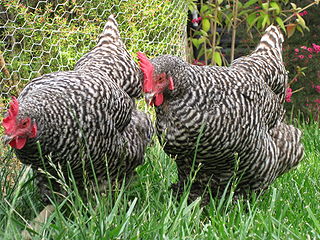
The Plymouth Rock is an American breed of domestic chicken. It was first seen in Massachusetts in the nineteenth century and for much of the early twentieth century was the most widely kept chicken breed in the United States. It is a dual-purpose bird, raised both for its meat and for its brown eggs. It is resistant to cold, easy to manage, and a good sitter.

The Randall Lineback or Randall is an American breed of cattle. It originated in Bennington County, Vermont, and is critically endangered.
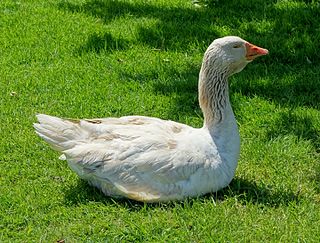
The American Buff is an American breed of domestic goose. It was accepted by the American Poultry Association in 1947. It is named for its single plumage variety, which is a pale buff or apricot-fawn in color.

The Bourbon Red is an American breed of domestic turkey. It is named for its reddish-brown plumage and for its area of origin, Bourbon County, Kentucky, where it was developed in the last years of the nineteenth century. It was accepted into the Standard of Perfection of the American Poultry Association in 1909, and in the early twentieth century was an important commercial meat breed until the Broad Breasted White began to dominate industrial production. The Bourbon Red is considered a heritage turkey; it is an endangered breed, classified as 'watch' by the Livestock Conservancy. It was formerly known as the Bourbon Butternut or as the Kentucky Red.

The Livestock Conservancy, formerly known as the American Livestock Breeds Conservancy (ALBC) and prior to that, the American Minor Breeds Conservancy, is a nonprofit organization focused on preserving and promoting rare breeds, also known as "heritage breeds" of livestock. Founded in 1977, through the efforts of livestock breed enthusiasts concerned about the disappearance of many of the US's heritage livestock breeds, The Livestock Conservancy was the pioneer livestock preservation organization in the United States, and remains a leading organization in that field. It has initiated programs that have saved multiple breeds from extinction, and works closely with similar organizations in other countries, including Rare Breeds Canada. With 3,000 members, a staff of eleven and a 19-member board of directors, the organization has an operating budget of over a million dollars.

The Buckeye is an American breed of chicken. It was created in Ohio in the late nineteenth century by Nettie Metcalf. The color of its plumage was intended to resemble the color of the seeds of Aesculus glabra, the Ohio Buckeye plant for which the state is called the 'Buckeye State'.
The Nankin Bantam or Nankin is a British bantam breed of chicken. It is a true bantam, a naturally small breed with no large counterpart from which it was miniaturised. It is of South-east Asian origin, and is among the oldest bantam breeds. It is a yellowish buff colour, and the name is thought to derive from the colour of nankeen cotton from China.

The Delaware is a breed of chicken originating in the U.S. state of Delaware. It was once of relative importance to the U.S. chicken industry, but today is critically endangered. It is primarily suited to meat production but also lays reasonably well. It has plumage of a unique pattern, and is accepted into poultry standards for showing.

The Java is a breed of chicken originating in the United States. Despite the breed's name, a reference to the island of Java, it was developed in the U.S. from chickens of unknown Asian extraction. It is one of the oldest American chickens, forming the basis for many other breeds, but is critically endangered today. Javas are large birds with a sturdy appearance. They are hardy, and are well-suited for both meat and egg production, especially by small-scale farms, homesteads, and backyard keepers.

A heritage turkey is one of a variety of strains of domestic turkey which retains historic characteristics that are no longer present in the majority of turkeys raised for consumption since the mid-20th century. Heritage turkeys can be differentiated from other domestic turkeys in that they are biologically capable of being raised in a manner that more closely matches the natural behavior and life cycle of wild turkeys. Heritage turkeys have a relatively long lifespan and a much slower growth rate than turkeys bred for industrial agriculture, and unlike industrially bred turkeys, can reproduce without artificial insemination.
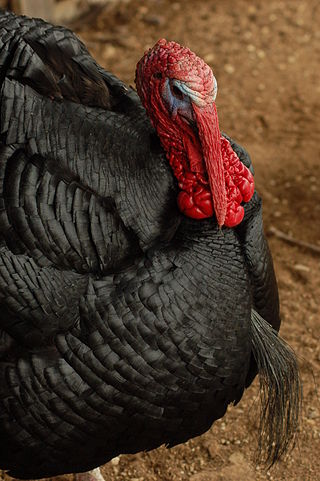
The Norfolk Black, also known as the Black Spanish or Black Turkey, is a British breed of domestic turkey. It is thought to derive from birds taken to Britain from Spain, where they had arrived with Spanish explorers returning from the New World.

The American Milking Devon is an American breed of dual-purpose cattle, reared both for milk and for beef. It derives from the Devon cattle of the United States, which in turn are derived from the North Devon cattle of south-west England. It was established as a separate breed in 1978 with the formation of the American Milking Devon Cattle Association, after the breeding aims of the Devon were concentrated almost exclusively on beef production. It is a rare breed: its conservation status is listed as by the Livestock Conservancy as 'critical'.

The Cotton Patch is a breed of domestic goose originating in the Southern United States. It is so named because it traditionally was used to weed fields of cotton, corn, and other crops.
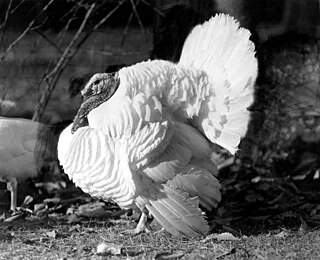
The Beltsville Small White is a modern American breed of domestic turkey. It was developed from 1934 at the Beltsville Agricultural Research Center of the United States Department of Agriculture in Beltsville, Maryland, and was named for that town and for its physical characteristics — small size and white plumage. It enjoyed a brief period of commercial success in the mid-twentieth century, but numbers then declined sharply; in the twenty-first century it is an endangered breed, and may be considered a heritage turkey breed.
The Buff or Jersey Buff is a breed of domestic turkey named for its buff-colored plumage.
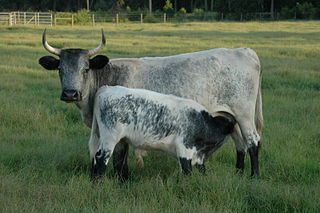
The Florida Cracker or Florida Scrub is an American breed of cattle which originated in Spanish Florida and later in the American state of Florida. It is named for the Florida cracker culture in which it was kept. It is one of the Criollo breeds that descend from the Spanish cattle originally brought to the Americas by the Spanish Conquistadors; among the other North American breeds in this group are the Pineywoods, the Corriente and Texas Longhorn. Unlike the Pineywoods – to which it is closely related – the Florida Cracker has not been inter-bred with breeds of North European origin.

The Ossabaw Island Hog or Ossabaw Island is a breed of pig derived from a population of feral pigs on Ossabaw Island, Georgia, United States. The original Ossabaw hogs are descended from swine released on the island in the 16th century by Spanish explorers. A breeding population has been established on American farms off the island, but they remain a critically endangered variety of pig.

The Guinea Hog is an American breed of small black pig. Since 2006 it has officially been named the American Guinea Hog. Its origins are unknown; a connection to the Essex pigs of eastern England has been suggested. It is apparently unconnected to an older pig also known as Guinea Hog or Red Guinea, which disappeared in the late nineteenth century.

The Midget White is a breed of domestic turkey named for its white plumage and small stature. The breed is the smallest standard variety of turkey, and with toms at roughly 13 lbs and hens 8-10 lbs, it weighs only slightly more than the largest chickens.
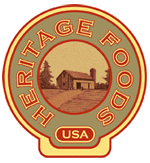
Heritage Foods USA is an American heritage meat distribution company with offices in Brooklyn, New York. It was formed in 2001 as the sales and marketing arm of Slow Food USA — a non-profit organization founded by Patrick Martins, dedicated to celebrating regional cuisines and ingredients. The Heritage Turkey Project, which helped double the population of heritage turkeys in the United States and upgraded the Bourbon Red turkey from “rare” to “watch” status on conservation lists, was Heritage Foods USA’s first project aimed at heritage breed preservation. In 2004, it became an independent company selling heritage breed meat to top tiered restaurants and consumers.



















